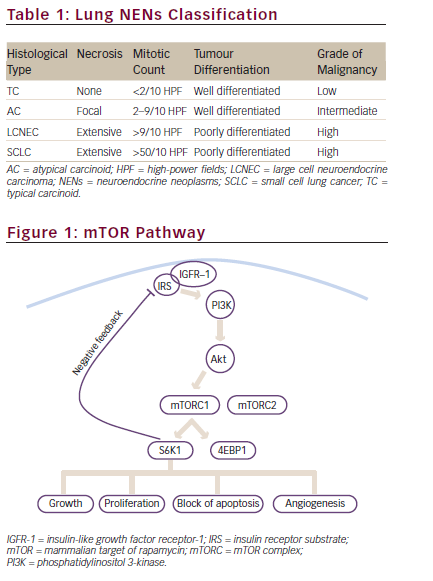Neuroendocrine tumours (NETs) are rare neoplasms that arise from neuroendocrine cells which are present throughout the body. NETs may be classified as functioning or non-functioning and are further differentiated based on the site of primary origin, histologic grade (low, intermediate or high) and proliferation rate.1 Functioning NETs are characterised by excessive hormone production and release, and cause hormonal syndromes (outlined in Table 1), while non-functioning NETs are not associated with a distinct hormonal syndrome – although they can secrete hormones and peptides at subclinical levels. Approximately 60–70 % of NET patients are diagnosed with disseminated metastatic disease.2 Even though many patients have indolent disease, some patients present with overtly aggressive tumours. Due to this heterogeneity, treatment is often individualised and may involve several modalities, such as cytoreductive surgery, non-surgical liver-directed therapies, somatostatin analogues, chemotherapy and, more recently, targeted agents.3 These treatments are used with two major objectives: to control the symptoms of hormone hypersecretion and to control tumour growth. The aim of this article is to review the antitumour effects of somatostatin (STS) analogues in the treatment of NETs.
Somatostatin
STS is a peptide produced by intestinal paracrine cells and plays a major role in inhibition of gastrointestinal (GI) endocrine secretion.4,5 STS acts as a paracrine, autocrine or neuronal regulatory molecule to inhibit glandular secretion, neurotransmission, smooth muscle contractility and absorption of nutrients, regulating the functioning of activated immune cells.5–7 STS exerts control over several neurophysiological functions, and is a pan-inhibitory agent for all known GI tract hormones.8 In the GI tract, STS promotes reduction of liver and splanchnic blood flow, inhibits GI and pancreatic secretions, inhibits gallbladder contractility and bile flow, slows GI transit, inhibits absorption of glucose and amino acids and inhibits tissue growth and proliferation.5
STS is a cyclic peptide. Its two biological molecular forms are somatostatin-14 (S-14) and somatostatin-28 (S-28), which are both expressed throughout the GI tract. STS is synthesised as part of a large precursor molecule that is cleaved, enzymatically processed and released by endocrine and nerve cells.9 STS binds to five different STS receptor subtypes (numbered 1–5) present at the surface of different endocrine cell types.
To view the full article in PDF or eBook formats, please click on the icons above.






